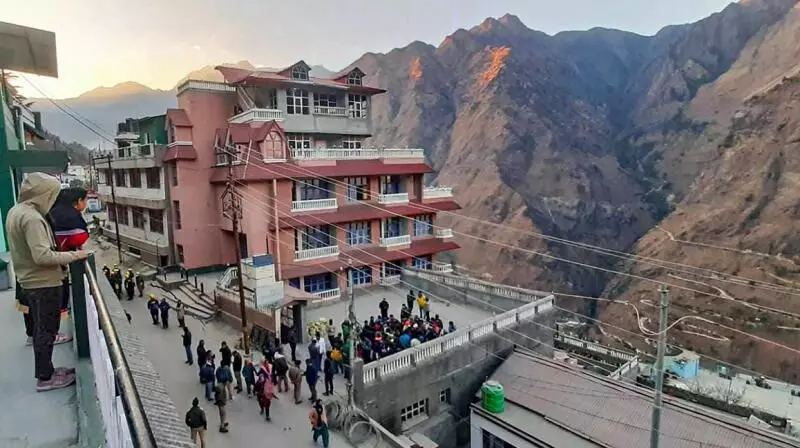Turning a blind eye?
As forgetfulness around the Joshimath crisis can pave way for similar disasters, there is a need for transparent and accountable recalibration of development projects

In late December 2022, the Joshimath land subsidence incident caught the attention of the nation. However, it is evident that the warnings of environmentalists, locals and expert committees formed by governments have been continuously ignored by successive administrations. Experts had raised the alarm at least 50 years ago when the Mishra Committee was formed by the then Uttar Pradesh government. In its report published in 1976, the committee had clearly identified that Joshimath was located on loose debris and was susceptible to disasters such as land subsidence and sinking. To make matters worse, Joshimath lies in seismic Zone V, which is classified as a high-risk zone by India's seismic zonation scheme, according to the National Centre for Seismology. The committee strongly advised against any form of heavy construction of buildings, roads and other large infrastructure projects in and around Joshimath. The report also suggested taking measures such as afforestation, building proper and robust wastewater disposal systems, and protecting the river bank erosion to preserve the area's fragile ecosystem.
However, subsequent governments seem to have turned a blind eye to these warnings and have proceeded with the construction of large, medium, and small development projects. The booming tourism sector and construction of large hotels in the area have also created additional pressure on the already fragile land.
Environmental amnesia
Amidst the big headlines about the land subsidence incident in Joshimath, the critical issues that pertain to the environment and ecosystem have nearly vanished from public attention. This is not surprising given that reports of land subsidence and landslides have emerged from various parts of the country. However, Joshimath gained greater attention probably due to its location. It is situated on the way to the major pilgrimage sites of Badrinath and Hemkund Sahib, along with the tourist sites in the Nanda Devi National Park. It is also a place of strategic importance near the Indo-Tibetan border.
The National Remote Sensing Centre (NRSC) reported a maximum subsidence of 8.9 cm between April and November 2022. However, between December 27, 2022 and January 8, 2023, the subsidence accelerated, and it subsided by a maximum of 5.4 cm. According to Uttarakhand State Disaster Management Authority (USDMA), by February 2023, at least 868 structures in almost all the nine wards of Joshimath had developed minor and major cracks, and around 232 families had been temporarily relocated to safer locations. Since the tragedy in last December-January, all the construction activities were halted, including TV-HEP by the Uttarakhand govt. However, the Hon’ble Uttarakhand High Court has recently allowed NTPC to carry out civil work in the tunnel at Joshimath, with strict restrictions on the use of explosives and heavy machinery in the tunnel. The civil construction activities in Joshimath town still remain at a standstill.
Tracing the genesis
Some environmentalists, activists and locals are of the opinion that the under-construction Tapovan Vishnugad Hydro-electric Power Plant (TV-HEP), associated with NTPC, and the Helang-Marwari two-lane bypass road, a major component of the Char Dham project, were behind the disaster in Joshimath. They point out that the tunnelling work beneath the Auli-Joshimath area has played a big role in the catastrophe. While there is no conclusive scientific study that ties land subsidence to tunnelling and blasting for developmental projects, the fault has been primarily attributed to the widespread construction of large buildings in Joshimath town. Back in 2009, two scientists — MP Bisht and Piyoosh Rautela — reported in 'Current Science' that an aquifer burst near the Shelang village was caused by a tunnel boring machine, and that led to a discharge of a huge volume of groundwater. Experts had predicted that catastrophic dewatering of rock strata might potentially initiate land subsidence in the area. On the other hand, constructing wider highways and expanding existing roads weakened the bases of slopes made up of loose debris. The 2021 Rishiganga flood was caused by a rock-glacier break from a steep mountain slope, which breached the Tapovan Dam and entered the tunnel. This event widened old cracks and created new ones, ultimately destabilising the slopes. This might have been another major triggering force behind the acceleration of the recent land subsidence.
Missing the points
The Mishra Committee report of 1976 and the more recent Chopra Committee report of 2014 warned that unregulated urbanisation and unchecked developmental activities, without considering the fragility of the Himalayas and conducting proper environmental impact assessments, could be disastrous. The authorities ignored these recommendations and warnings, resulting in ecological, environmental, and socio-cultural losses across large swathes of the Himalayas. Furthermore, the Chopra Committee rightly pointed out that the government and private players are pushing for harnessing the hydropower potential as green and renewable energy in the Himalayas. With a warming climate, we must rethink our approach.
Reimagining development in the Himalayas
The Joshimath tragedy highlighted the consequences of ignoring warnings, and questioned governments' commitment towards conserving the environment and the people. Development projects must be carefully scrutinised to balance developmental targets with nature conservation, especially in fragile ecosystems. Additionally, many Himalayan states, reliant on tourism revenue to a great extent, need to regulate growth to avoid overwhelming the land’s carrying capacity. Tourism should be diversified beyond existing concentrated sites to distribute the burden. Sustainable development should prioritise environmental conservation and deploy transparent, rigorous, and effective environmental clearance processes. However, caution is necessary when embracing the "small is beautiful" approach to prevent harm in sensitive areas. A comprehensive approach is required, emphasising careful assessment, transparency, and sustainability.
Pradip Burman is Chairman, Mobius Foundation, New Delhi; and Sandip Tanu Mandal is Research Associate, Mobius Foundation. Views expressed are personal



